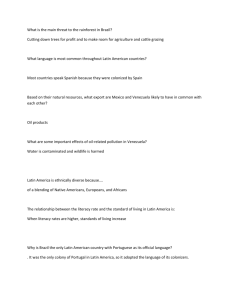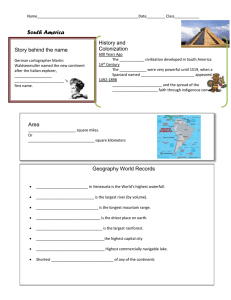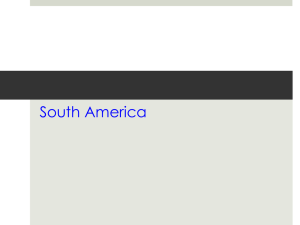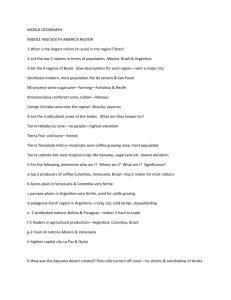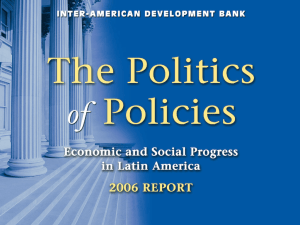South America
advertisement
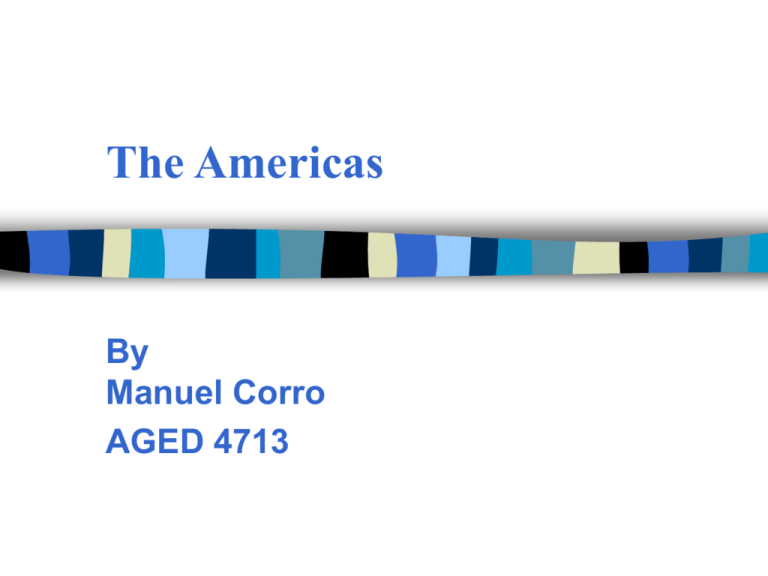
The Americas By Manuel Corro AGED 4713 The American Continent Three in one North America Central America South America North America Canada The United States Mexico North American Free Trade Agreement (NAFTA 1994) Latin America Latin America, the entire western hemisphere south of the United States. Latin America comprises those countries of the Americas that developed from the colonies of Spain, Portugal, and France. Latin America Because these European powers used languages derived from Latin, the term Latin America was devised to designate the parts of the New World that they colonized. • Spanish • Portuguese • French Latin America Spanish is the official language in 17 countries in North, Central And South America and Two Caribbean countries One Portuguese country: Brazil French: Haiti Non Latin countries Central America • English: Belize South America: • English: Guyana • Dutch: Suriname Caribbean • English: Jamaica, Barbados, Grenada, and Trinidad and Tobago Mexico Mexican Southern states State Yucatán Quintana Roo Campeche Tabasco Chiapas Capital city Mérida Chetumal Campeche Villahermosa Tuxtla Gutiérrez • Quintana Roo has border with Belize • Campeche has borders with Belize and Guatemala • Tabasco and Chiapas have border with Guatemala Central America 7 countries 521,500 sq km(201,300 sq mi) 36.4 million inhabitants Geographers defined: from isthmus of Tehuantepec (southern Mexico) to Colombia Farming is the leading economic activity The principal cash crops, such as coffee, bananas, sugarcane, and cotton. Central America Countries and capital cities Guatemala Belize El Salvador Honduras Nicaragua Costa Rica Panama Guatemala Belize San Salvador Tegucigalpa Managua San Jose Panama Foreign Trade About half of Central America's intercontinental trade is with the United States and Canada. Almost all the rest is with Western Europe, Mexico, and countries of South America. The main exports are basic commodities: bananas, coffee, cacao, meat, chicle, cotton, mahogany, balsa, hides and skins, and rubber. Caribbean Basin Initiative (1984) and the North American Free Trade Agreement (NAFTA) (1994) Caribbean countries Cuba Jamaica Haiti Dominican Republic Barbados Grenada Trinidad and Tobago La Habana (Havana) Kingston Port Prince Santo Domingo Bridgetown St. George’s Port of Spain South America South America: South America, fourth largest of the Earth's continents (after Asia, Africa, and North America) 17,820,900 sq km (6,880,700 sq mi), or 12 percent of the Earth's land surface. 2000 estimated population of 348 million, or 6 percent of the world's people. South America: Countries and Capital cities Colombia Venezuela Ecuador Brazil Peru Bolivia Paraguay Argentina Uruguay Chile Bogota Caracas Quito Brasilia Lima La Paz Asuncion Buenos Aires Montevideo Santiago South America: Non Latin countries Guyana Suriname French Guiana Georgetown Paramaribo Cayenne South America: People Language: • 9 countries speak Spanish • 1 country speaks Portuguese • Other languages: English, Dutch and French • Paraguay 2 official languages: Spanish & Guaraní Ethnology: Diverse ethnic heritage • • • • • Europeans: Spaniards, Portuguese, Native Americans African blacks Mestizo Mulatto South America: People Total population 348 million Ecuador Chile Others Venezuela Brazil 50 % Peru Argentina Colombia South America: Agriculture Most crop and livestock production in South America is for home consumption and domestic markets. Staple food: • Root crops: potatoes and cassava • Grains: rice, wheat, beans, and corn Export-oriented agriculture is pursued in the tropical areas and mid-latitudes. South America: Agriculture (continued) Tropical crops, coffee is the most important (southeastern Brazil and in west central Colombia) Cacao is important in eastern Brazil and west central Ecuador. Bananas are grown for export in Colombia and western Ecuador Sugarcane for export in coastal Peru, Guyana, Suriname, and northeastern and southeastern Brazil for export and domestic markets. Argentina and Uruguay have good grass grassy plains for raising cattle. South America: Agriculture (continued) Argentine wheat, corn, linseed, beef, mutton, hides, and wool are important items of international trade. Uruguay has a long-standing export trade dominated by beef, wool and hides. In southeastern Brazil soybeans have, since the 1970s, become an important export crop. Soybeans are less important in Argentina South America: trade Most of South America's trade is intercontinental, the United States, Western Europe, and Japan being major trading partners. Petroleum and its derivatives are the principal components of foreign trade. Brazil and Venezuela dominate the continent's export trade, and Brazil accounts for much of the imports. South America: trade (continued) •Venezuela's crude and refined oil production drive the economy, accounting for about three-quarters of the country's revenue from exports. •A founding member of the Organization of Petroleum Exporting Countries (OPEC), most of Venezuela's oil production goes to the United States after refining in the Netherlands Antilles. South America: trade The development of free trade, beginning in the late 1960s with the Andean Pact (Bolivia, Chile, Colombia, Ecuador, Peru, and Venezuela) Southern Cone Common Market (MERCOSUR) (Argentina, Brazil, Paraguay, and Uruguay, with Bolivia as an associate member) The Group of Three (Colombia, Mexico, and Venezuela) North American Free Trade Agreement (NAFTA), has greatly improved South America's economic prospects. São Paulo is one of Brazil's major manufacturing centers. References David J. Robinson, B.A., Ph.D. ”Central America". Microsoft® Encarta® Online Encyclopedia 2001 http://encarta.msn.com (20 Nov. 2001) "South America". Microsoft® Encarta® Online Encyclopedia 2001 http://encarta.msn.com (20 Nov. 2001)




